Peonies are living treasures in garden design, offering beauty and longevity to any landscape.
These flowers have graced gardens for centuries, from ancient Chinese imperial courts to modern American backyards.
Peonies create striking focal points in the garden with their large, layered blooms and rich green foliage. Their versatility shines through in every setting, from formal borders to casual cottage gardens.
Some plants bloom faithfully for over 100 years, passing through generations of gardeners.
This guide walks you through creating your peony-filled landscape. We’ll cover everything from selecting the right varieties to maintaining healthy plants year after year.
Whether you’re planning your first peony planting or expanding an existing garden, you’ll find the knowledge you need to succeed.
Choosing the Right Peony for Your Garden
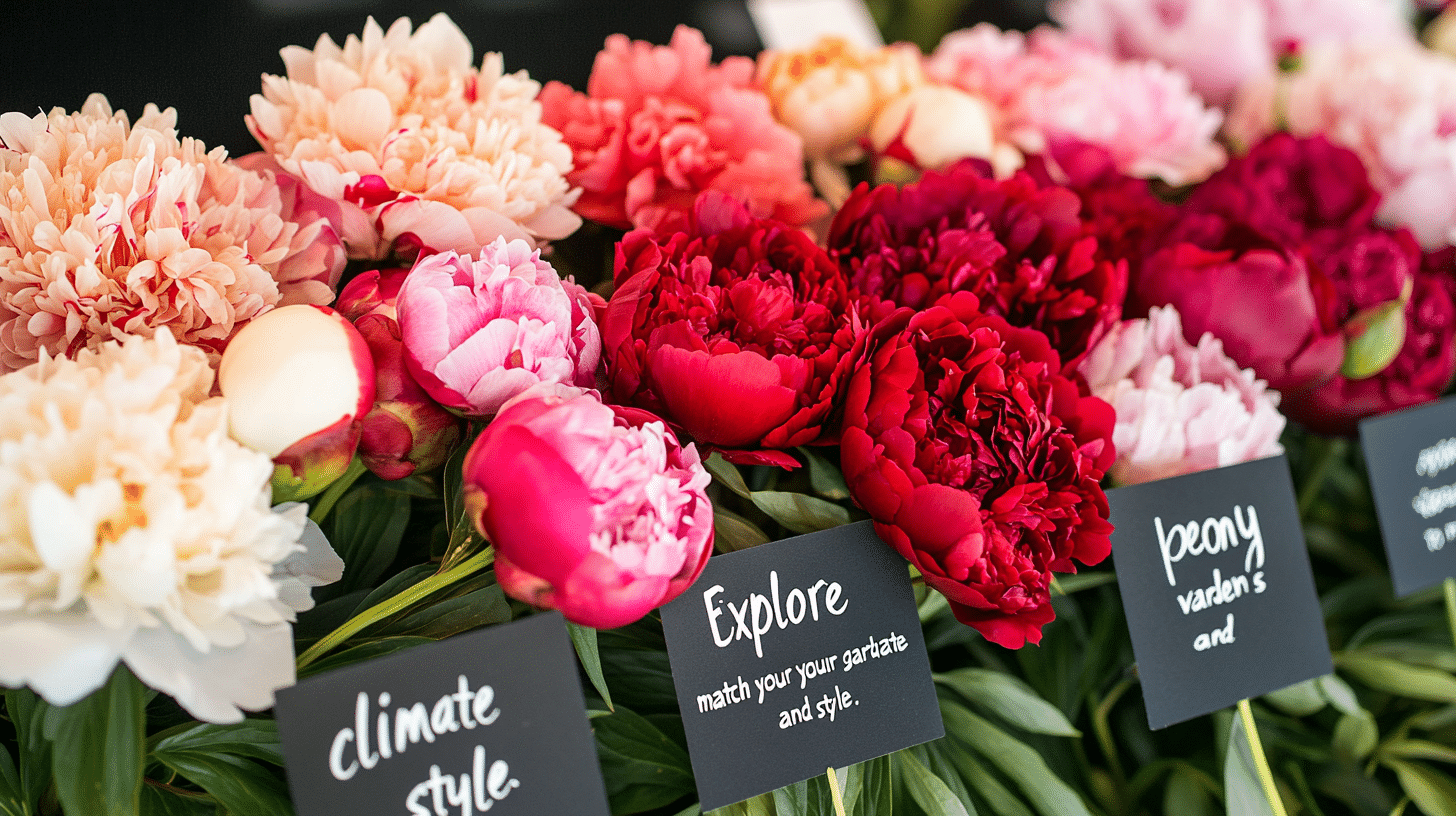
Climate and Design Preferences
Your garden’s climate plays a key role in peony selection. These plants can thrive in growing zones 2 through 8, making them suitable for most North American gardens.
Light exposure in your garden helps determine which peony type will work best.
Most peonies need 6 to 8 hours of sunlight daily to produce the best blooms, though tree peonies can manage with partial shade.
When selecting peonies, consider the size of your garden space. Herbaceous varieties typically reach 2 to 3 feet tall, while tree peonies can grow up to 7 feet tall.
Matching Peony Varieties to Landscape Needs
Start by considering how you want to use peonies in your garden. Some gardeners prefer them as border plants, while others create dedicated peony beds for maximum impact.
The bloom time varies among peony types, affecting your garden’s seasonal display.
Early-blooming tree peonies flower around Mother’s Day, while herbaceous varieties typically bloom near Memorial Day.
Think about your garden’s existing features and how peonies will complement them.
These plants work well with formal and natural garden styles, adding structure and color to your landscape.
Understanding Peony Varieties
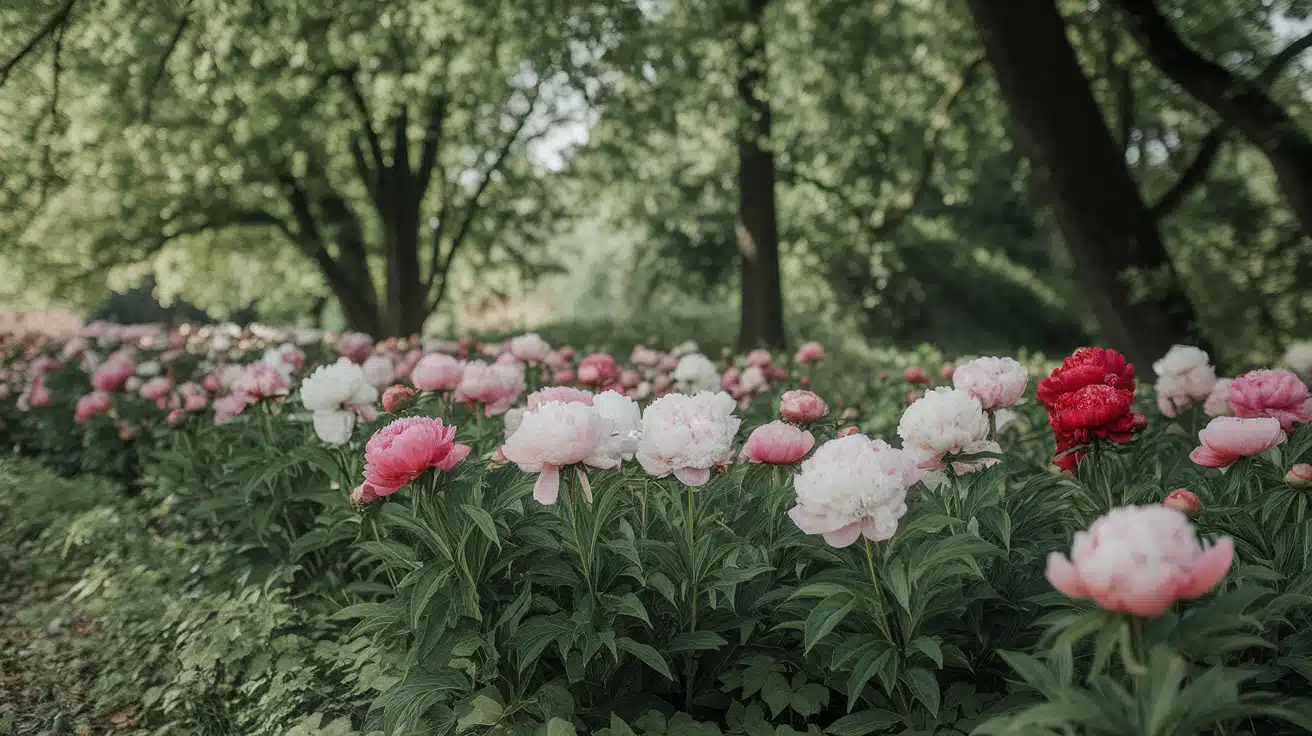
Herbaceous, Tree, Intersectional, and Woodland Peonies
| Type | Height | Bloom Time | Special Features | Best Use |
|---|---|---|---|---|
| Herbaceous | 2-3 feet | Late spring | Dies to ground in winter; Excellent cut flowers | Borders, cutting gardens |
| Tree | 4-7 feet | Early spring | Woody stems; Permanent structure | Focal points, backgrounds |
| Intersectional | 2.5-3.5 feet | Mid-spring | Best of both types: Strong stems | Low-maintenance beds |
| Woodland | 1-2 feet | Early spring | Shade tolerant; Self-seeding | Naturalized areas, forest edges |
Peonies form the backbone of many traditional gardens.
These perennials die back to the ground each winter and return in spring, producing large flowers on soft stems.
Tree peonies stand out with their woody stems that stay upright year-round.
Unlike their herbaceous cousins, they maintain a shrub-like presence in the garden and can reach impressive heights.
Intersectional peonies blend the best traits of both types.
They offer the sturdy growth habit of tree peonies with the convenience of herbaceous varieties, creating a compact, well-behaved plant.
Woodland peonies thrive in partially shaded areas. These early bloomers naturalize well under deciduous trees, perfecting them for forest-edge gardens.
Peonies’ Unique Qualities and Where They Excel
Herbaceous peonies make outstanding cut flowers. Their long stems and large blooms create stunning bouquets that last over a week in water.
Tree peonies work well as focal points in the landscape.
Their permanent structure provides year-round interest, while their massive flowers create dramatic spring displays.
Intersectional varieties shine in modern gardens.
They rarely need staking and produce numerous blooms over an extended period, making them low-maintenance choices.
Each type brings different colors to your garden palette.
Tree peonies offer rare yellows and deep purples, while herbaceous types excel in pinks, whites, and reds.
Planning Your Peony Landscape
1. Assessing Garden Conditions
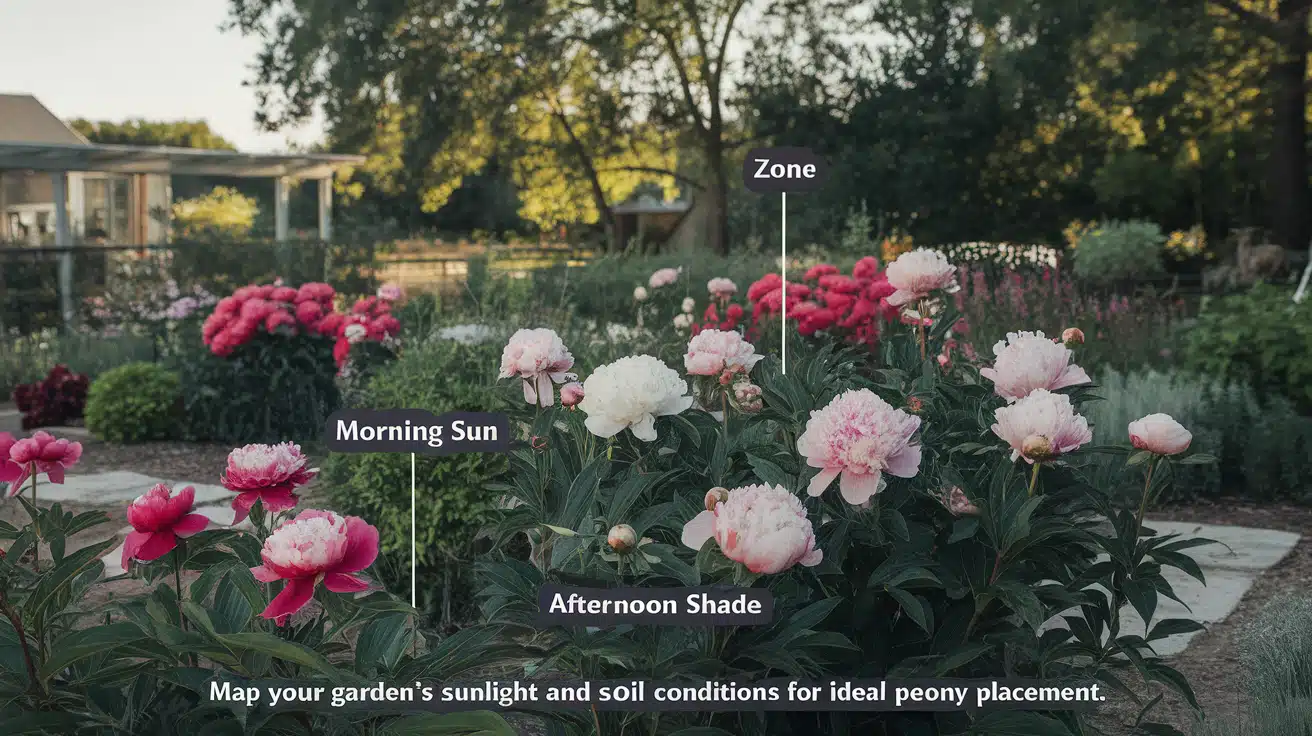
Successful peony gardens begin with a thorough site assessment.
Check your soil drainage by digging a test hole and filling it with water – it should empty within 24 hours.
Look at how sunlight moves across your garden throughout the day.
To place each peony type appropriately, map out areas that receive morning sun versus afternoon heat.
Your soil’s pH level affects peony growth and bloom quality. Most peonies prefer slightly neutral soil with a pH between 6.0 and 7.0.
2. Design Principles for Impactful Layouts
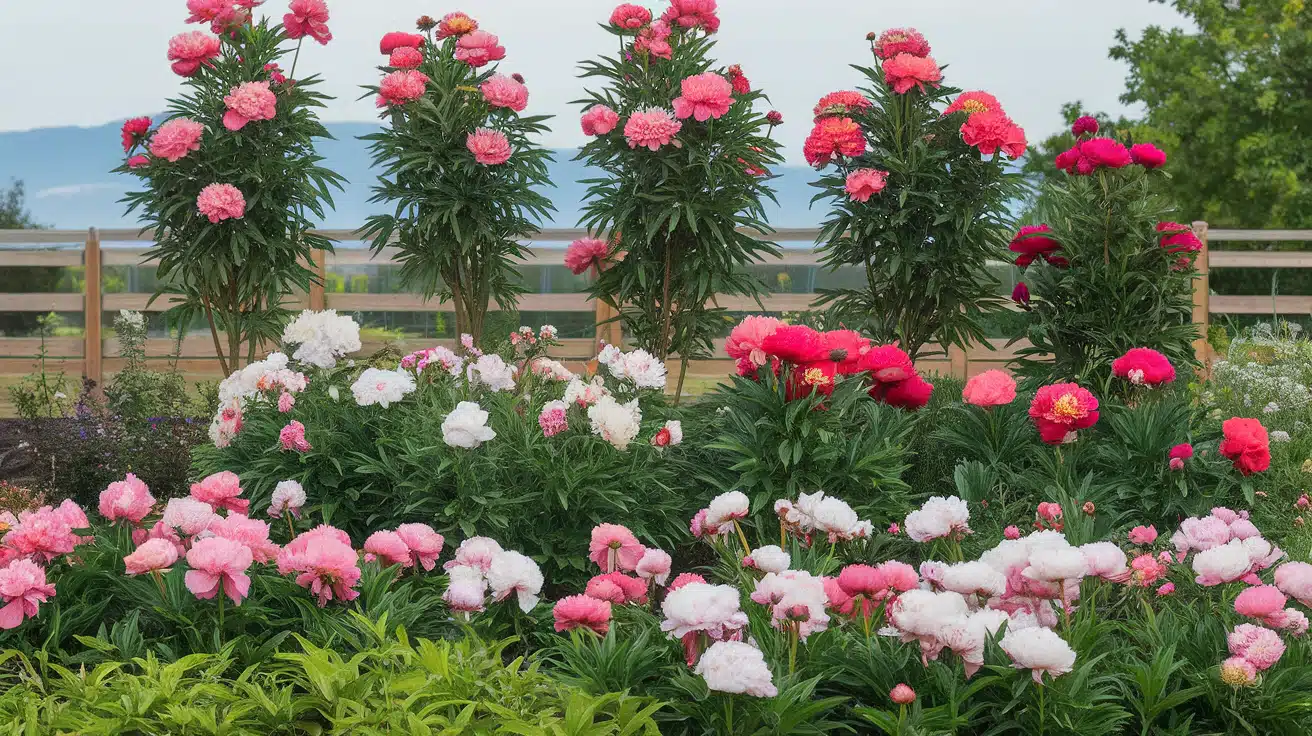
Create depth in your garden by placing taller tree peonies toward the back.
Put shorter herbaceous varieties in the middle ground, with low-growing companions at the front.
Space your peonies properly to prevent future crowding.
Allow 3 to 4 feet between herbaceous peonies and 4 to 5 feet for tree peonies.
When planning pathways and sitting areas, consider the mature size of your peonies. Remember that these plants can live for decades in the same spot.
3. Companion Planting for Continuous Blooms
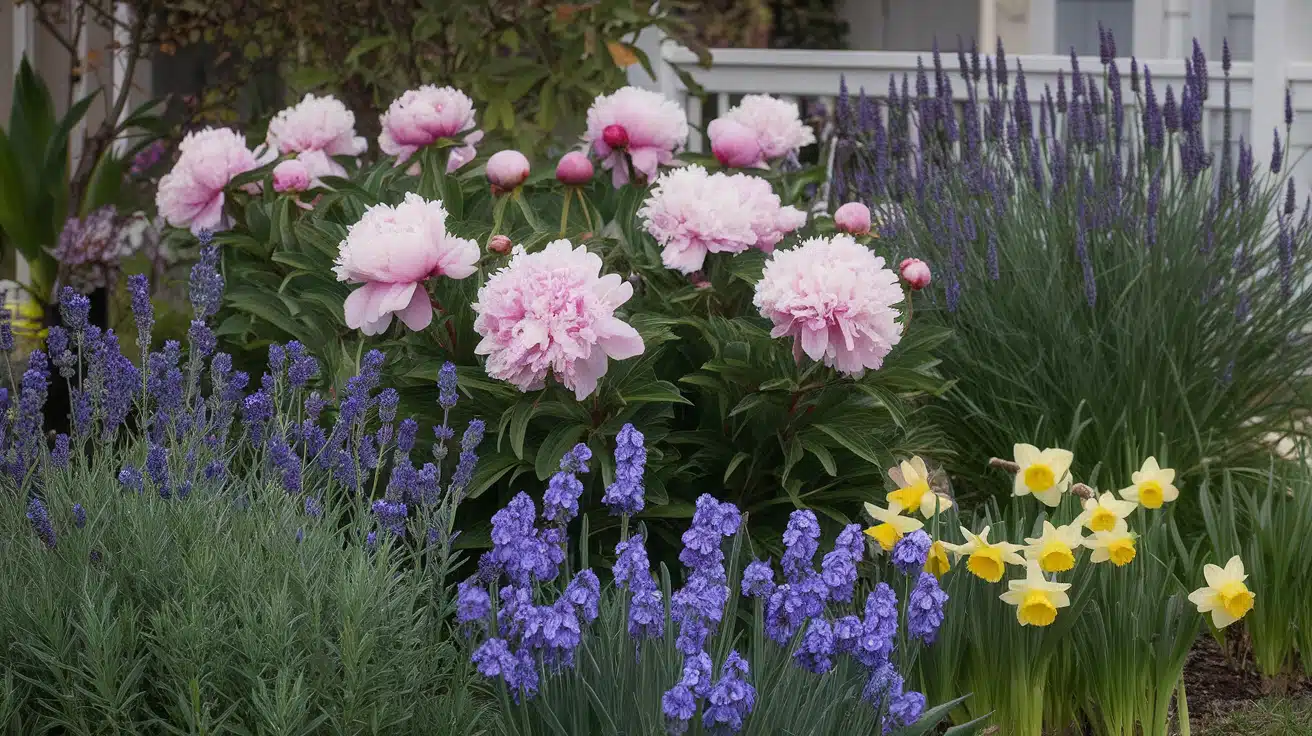
Plant spring bulbs between peonies to add early color. Small bulbs like grape hyacinths and daffodils bloom before peony foliage fills out.
Add summer-blooming perennials to maintain interest after peony flowers fade.
Plants like salvias and hardy geraniums extend the color season.
Choose companions that share similar growing needs.
Lavender, catmint, and ornamental grasses make good neighbors because they prefer well-drained soil.
Planting Peony Bushes
When to Plant and Site Preparation
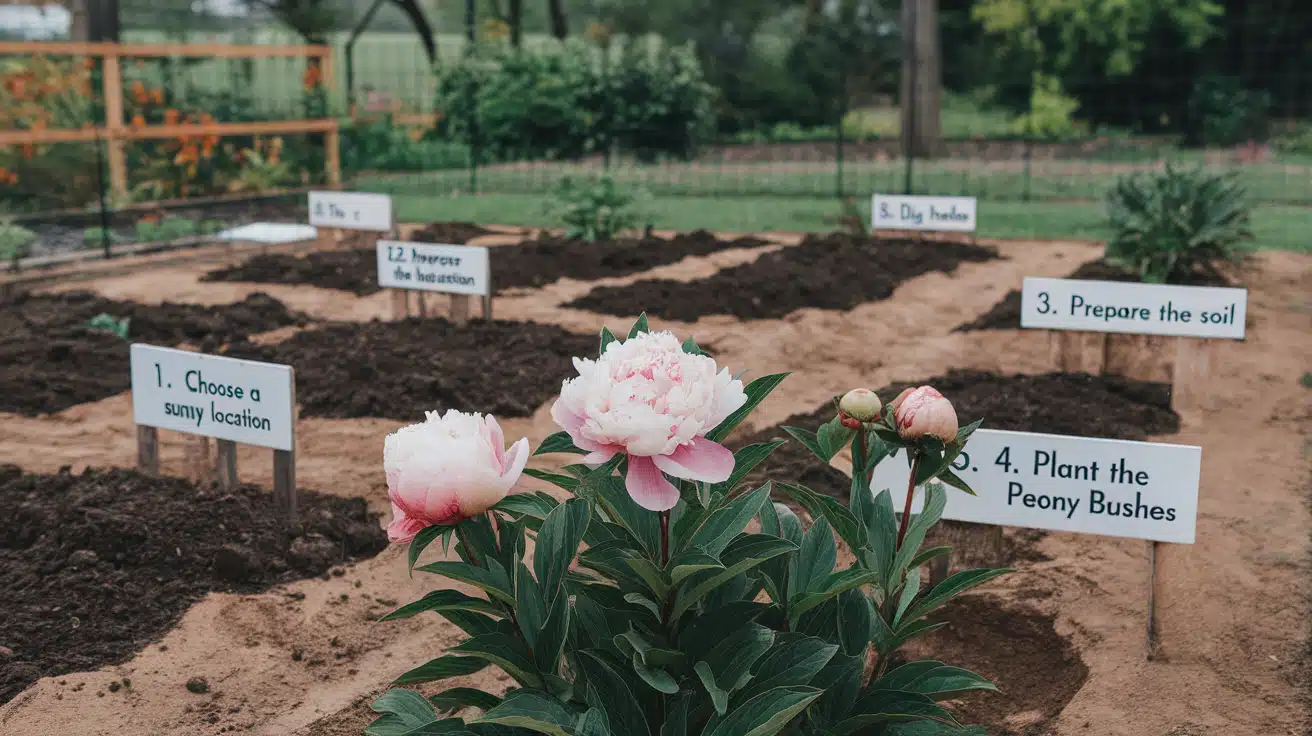
Fall offers the best time to plant peonies in your garden.
The cooling soil helps roots establish before winter arrives, giving plants a head start for spring growth.
Prepare your planting site by completely removing weeds and grass.
Break up the soil to a depth of 12 to 18 inches, mixing in organic matter to improve drainage.
The right soil mix helps peonies thrive for decades.
Create a blend of native soil with compost to ensure good structure and nutrients for long-term growth.
Planting Techniques (Bareroot vs. Potted)
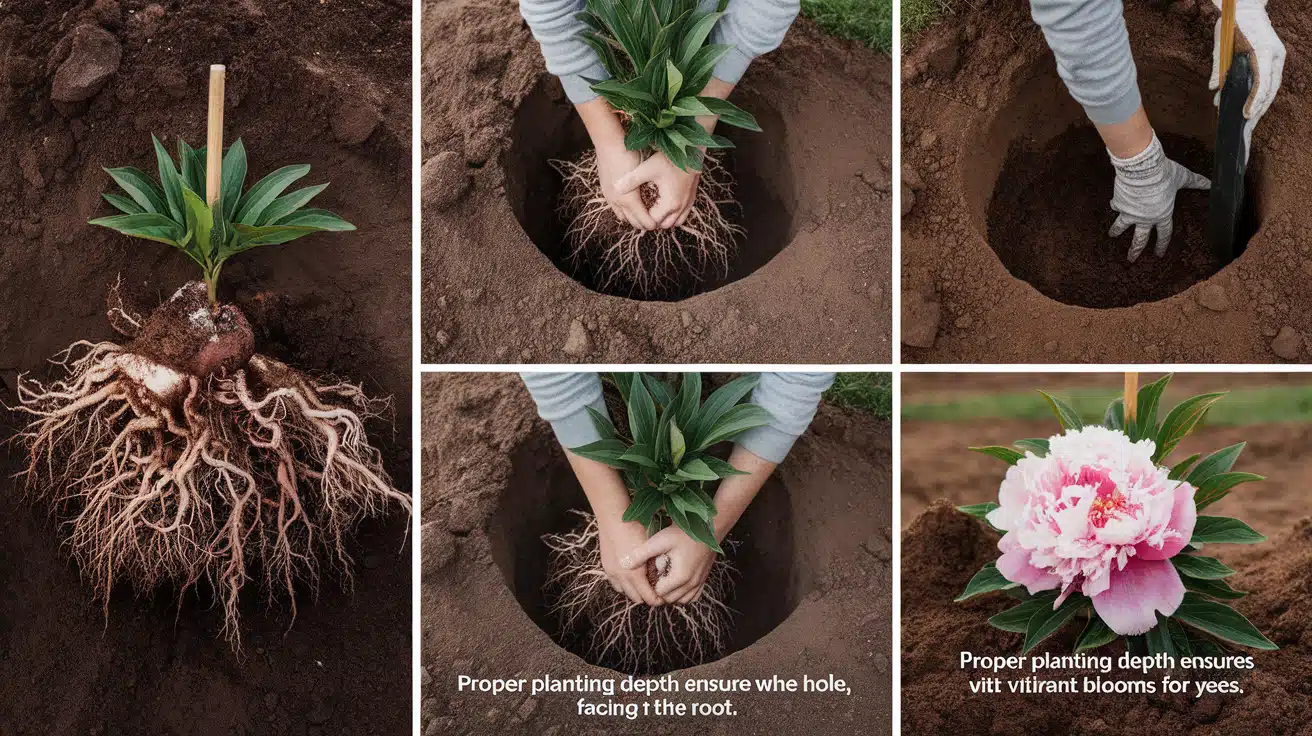
Bareroot peonies need careful attention to planting depth. Set the pink growth buds in cold regions, called eyes, just 2 inches below the soil surface and 1 inch in warmer areas.
Potted peonies should sit at the same depth they grew in their container. Gently loosen the root ball before placing it in the hole to encourage outward growth.
Water newly planted peonies deeply, but avoid soaking the soil. A gentle shower helps remove air pockets without creating muddy conditions.
Let the soil settle naturally around your newly planted peonies. Avoid pressing or compacting the soil too firmly, restricting root growth.
Monitor your plantings through the first few weeks. Add a light layer of mulch to conserve moisture, keeping it away from the plant stems.
Caring for Peonies Through the Seasons

Seasonal Care Tips: Spring, Summer, Fall, and Winter
Spring brings the first peony shoots from the soil. Gradually remove old mulch as new growth appears, and watch for any signs of frost damage.
Support stems early in spring before they get too tall. This prevents the heavy blooms from bending or breaking later in the season.
Summer care focuses on maintaining clean foliage. Immediately remove spent blooms and keep the area around plants free from fallen petals.
Fall signals the time for cleanup and protection. After the first frost, cut herbaceous peony stems to the ground but leave tree peony branches intact.
Established plants require minimal care in winter. A light mulch layer protects roots in very cold regions, but avoid covering the crown too deeply.
Summary Table for Easy Reference
| Season | Main Tasks |
|---|---|
| Spring | Remove mulch, add supports |
| Summer | Clean spent blooms, water as needed |
| Fall | Cut back plants, clean garden |
| Winter | Light mulching, minimal care |
Follow these seasonal guidelines to maintain healthy peonies. Regular attention throughout the year leads to decades of beautiful blooms.
Maximizing Peony Bloom and Health
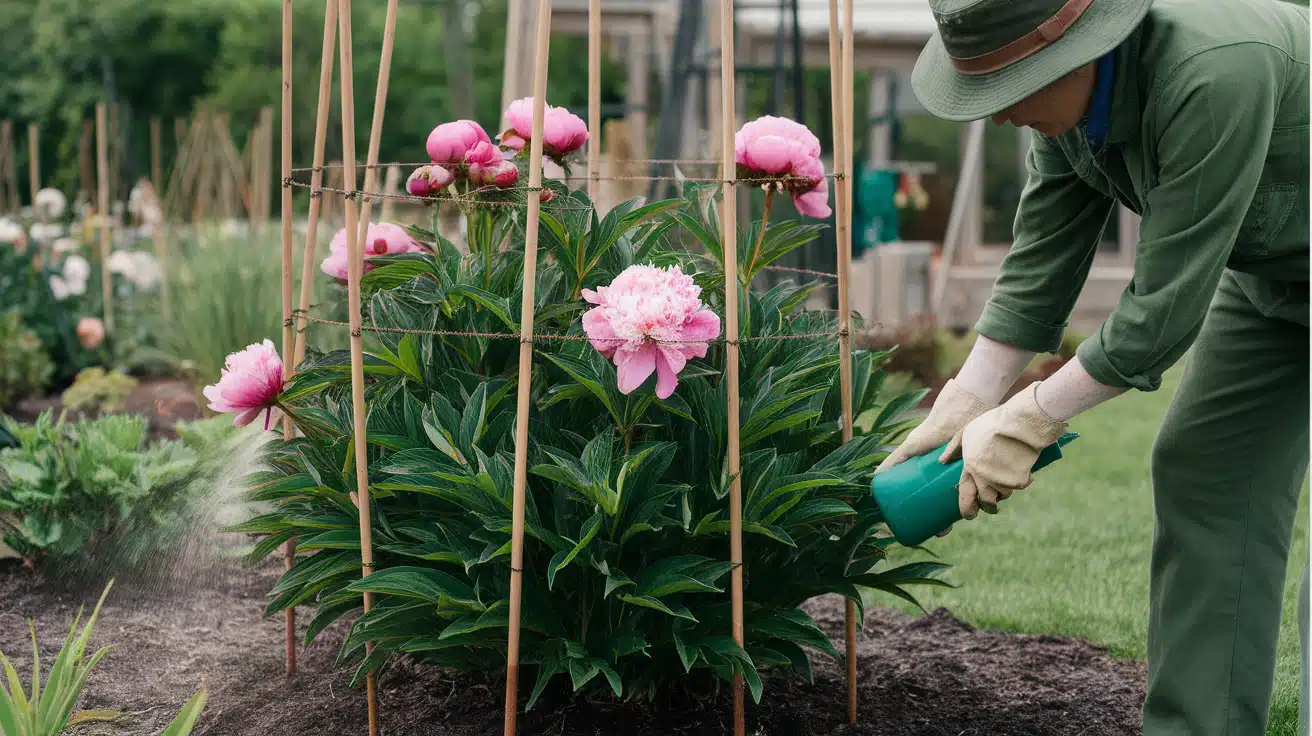
Fertilization, Watering, and Staking
Proper watering sets the foundation for healthy blooms. When rain is scarce during the growing season, give your peonies about one inch of water weekly.
Fertilize peonies sparingly in early spring. A light application of balanced fertilizer around the plant base supports growth without causing excess foliage.
Strong stems need proper support to hold heavy blooms. Place support rings or stakes in early spring when plants are just a few inches tall.
Organic Care Methods for Eco-conscious Gardeners
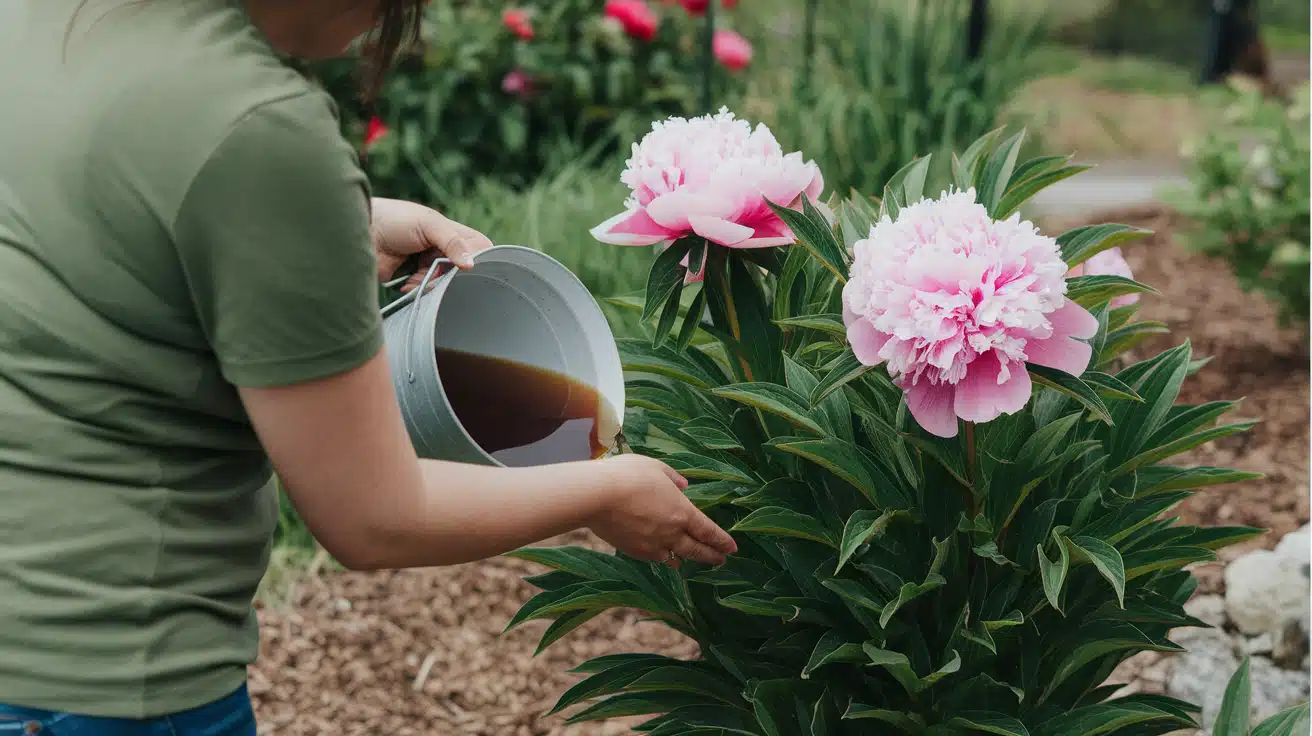
Compost tea provides natural nutrients for peonies. Apply it monthly during the growing season to boost plant health without harsh chemicals.
Organic mulch materials keep the soil healthy. Wood chips or leaf compost feed the soil slowly while keeping weeds down.
Natural pest control methods work well with peonies. Hand-picking insects and maintaining good airflow prevent most pest problems.
Build soil health naturally over time. Add a thin layer of compost each spring to feed beneficial soil organisms and improve structure.
Monitor plant health through observation. Healthy peonies resist problems better, reducing the need for treatments.
Common Mistakes to Avoid
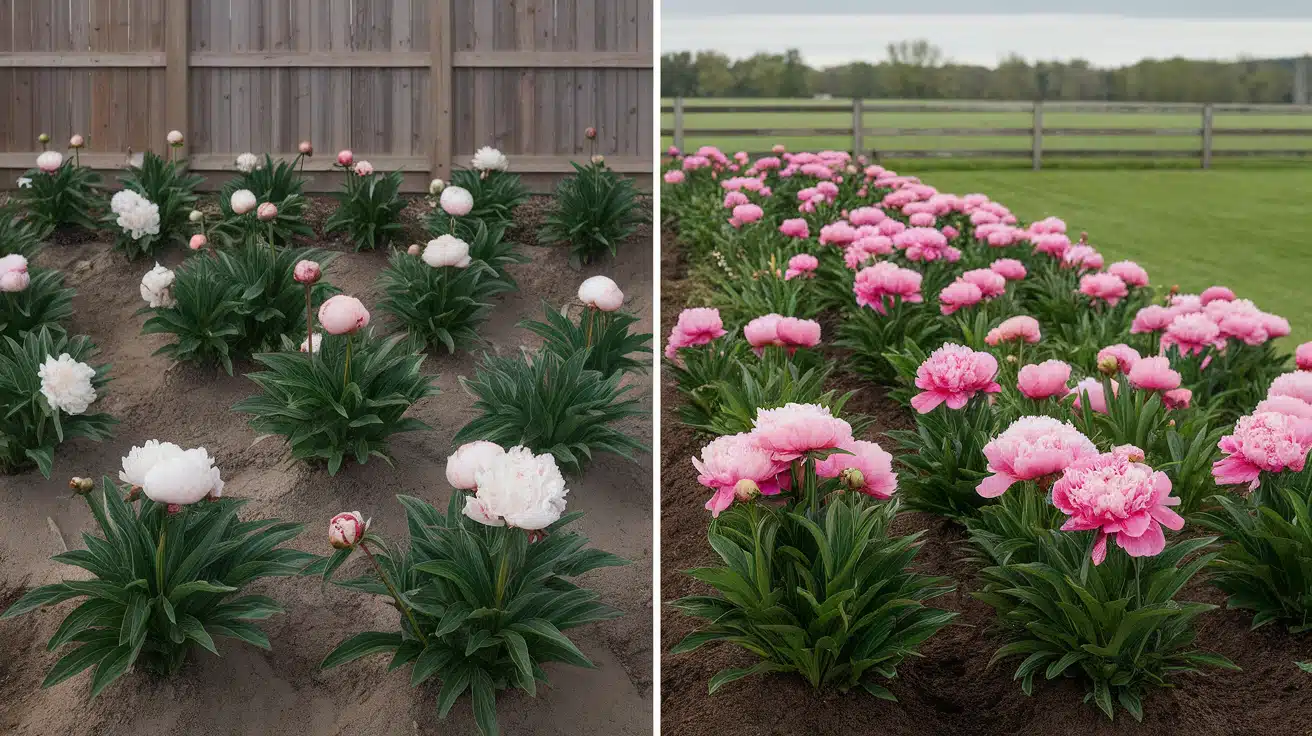
Planting Too Deep/Shallow and Overwatering
The number one problem with peonies is incorrect planting depth. Plant eyes (growth buds) too deep, and your peony might grow but won’t flower.
The right depth varies by type. Set herbaceous peony eyes 1-2 inches below soil level and tree peony grafts 4-6 inches deep.
Overwatering causes more harm than drought. Wet soil leads to root rot and weak plants that produce few flowers.
Ignoring Divisions and Dealing with Root Rot
Skip regular divisions, and your peonies might stay healthy. Unlike many perennials, peonies don’t need frequent splitting to remain strong.
Watch for signs of root rot in your plants. Yellow leaves, soft stems, and foul-smelling soil indicate problems below ground.
Fix root rot by improving drainage first. Remove affected roots, reduce watering, and add coarse sand to heavy soils.
Avoid overcrowding new plantings. Give each peony enough space to grow, even if the bed initially looks sparse.
Remember that peonies prefer staying put. Once established in a good spot, they can bloom happily for decades without much fuss.
Conclusion
Creating a stunning landscape with peonies rewards gardeners with decades of beauty and enjoyment.
Your peony garden can become a cherished part of your outdoor space by choosing the right varieties, planning carefully, and following proper care guidelines.
Remember that success with peonies comes from patience and attention to basics: proper planting depth, good drainage, adequate sunlight, and seasonal maintenance.
Don’t be discouraged if your peonies take a few years to reach their full potential – these long-lived plants are worth the wait.
As you begin your peony gardening journey, observe how your plants grow and respond to care.
Each garden is unique, and your experience will help you create the perfect conditions for these enduring flowers to thrive in your landscape for years to come.

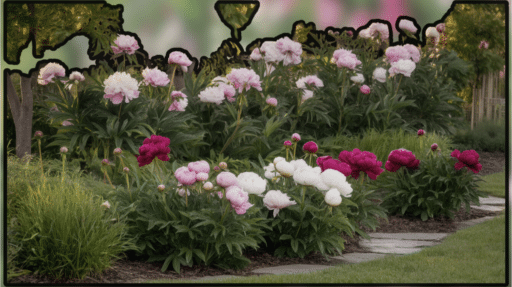
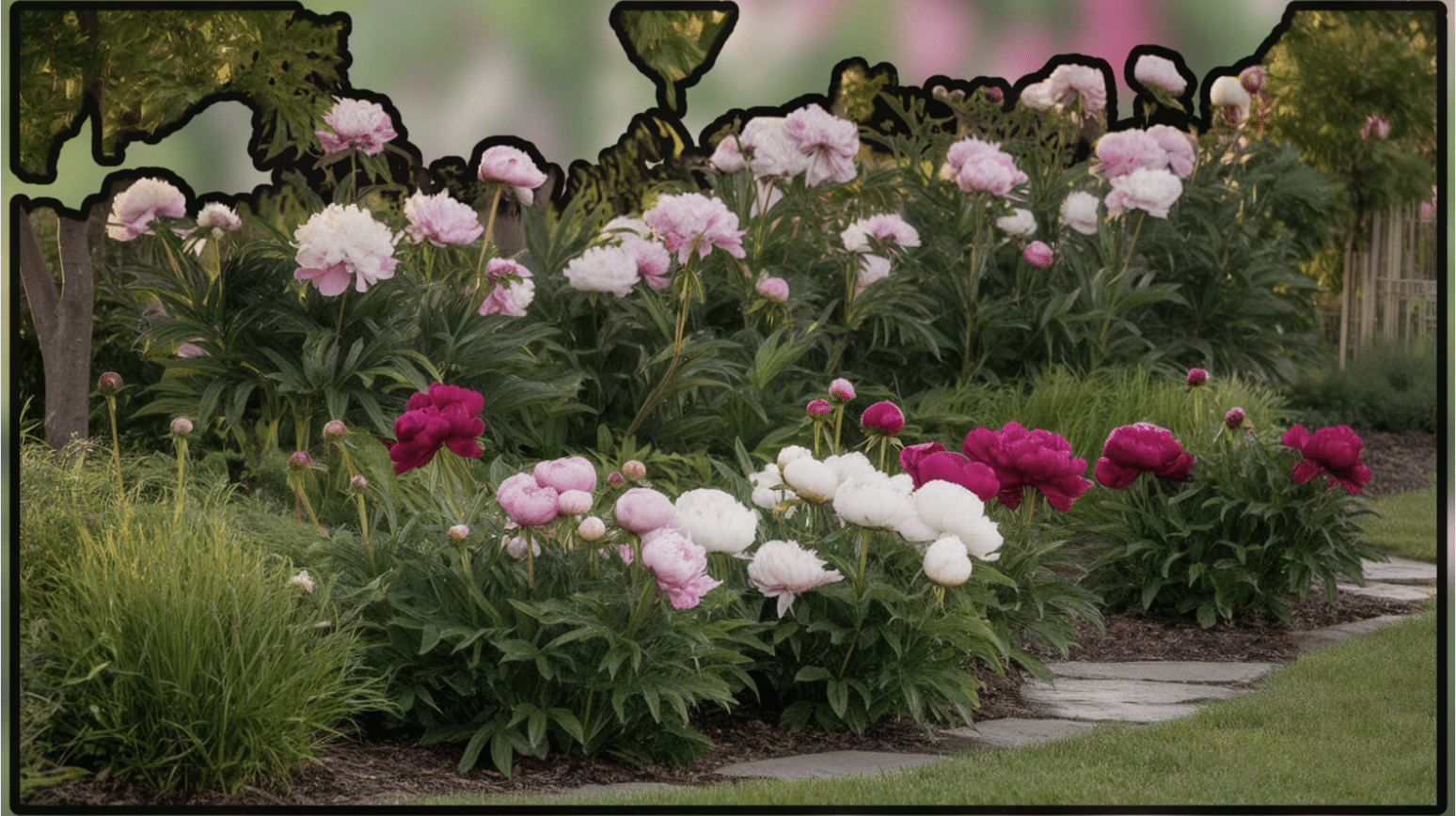





![20 front yard succulent garden ideas[P]](https://cdn.enthrallinggumption.com/wp-content/uploads/2023/12/20frontyardsucculentgardenideas-512x288.jpg)